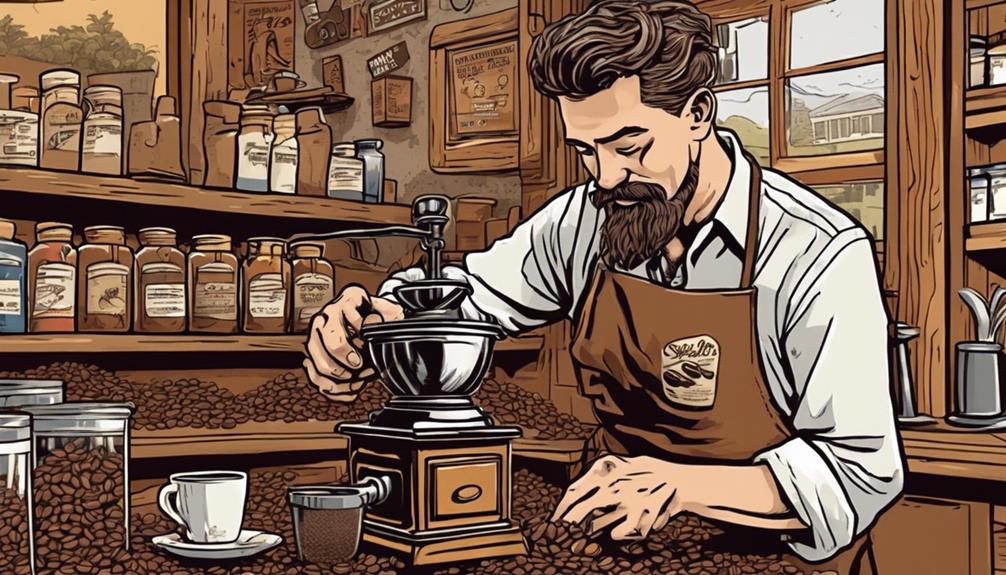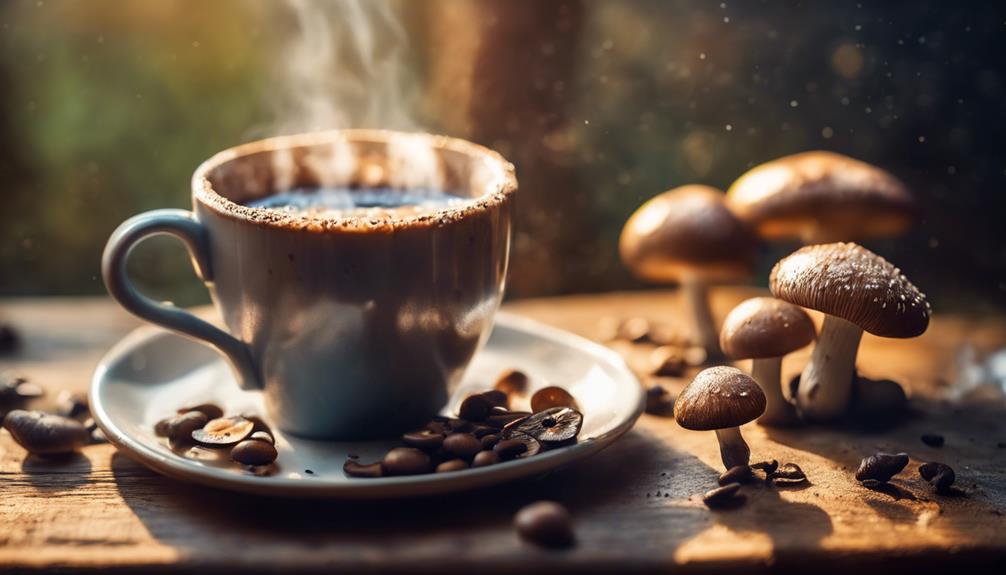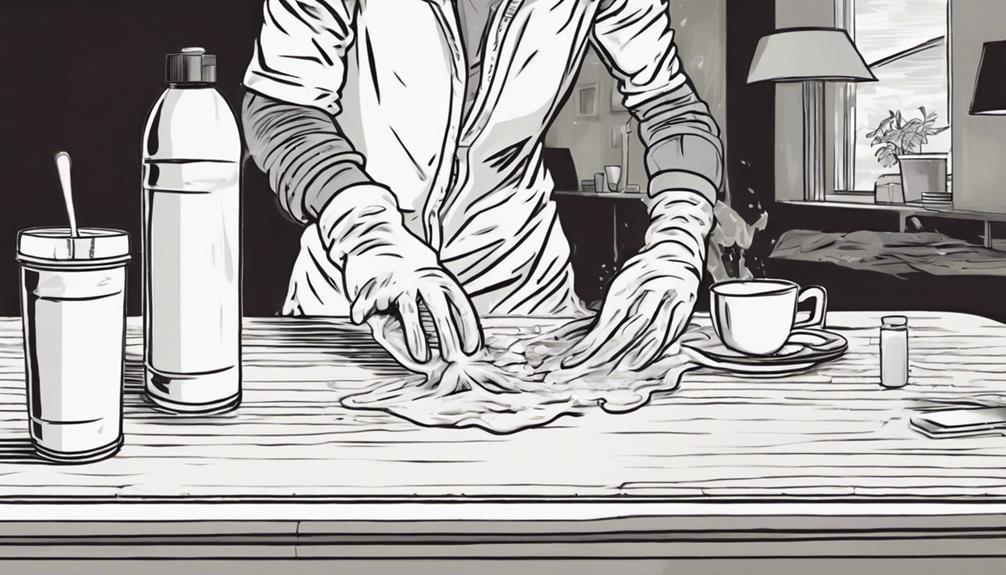To create the perfect espresso, start by mastering the skill of blending different beans. Achieve a well-rounded flavor profile by utilizing beans from different regions. Try out single origin options for a unique taste adventure. Take into account how the origins of the beans affect the aroma and flavor. Pay close attention to water quality and brewing techniques for optimal extraction. Experiment with varying roast levels to bring out different flavors. Refine your abilities in crafting the perfect blend to take your espresso game to the next level. Your journey to espresso greatness starts with the ideal blend – a harmony of flavors ready to tantalize your taste buds.
Key Takeaways
- Master blending techniques for balanced espresso.
- Combine beans from various origins for unique flavors.
- Consider single origin beans for distinct aroma influence.
- Experiment with roast levels to enhance flavor profiles.
- Craft exquisite blends through dedication and understanding.
Blending Basics
To master the art of blending coffee for the perfect espresso, you must first understand the fundamental principles of blending basics. When it comes to crafting quality espresso blends, blending techniques play a pivotal role. Expertise and experimentation are essential in combining different coffee beans to achieve a balanced and unique flavor profile. Roasters often blend beans from various regions to create a harmonious taste that satisfies the palate.
The roast level of the beans is another vital aspect to ponder when blending for espresso. Understanding how roasting affects flavors and aromas is paramount in creating a successful espresso blend. It's essential to select high-quality beans for blending to secure that the final product is rich, flavorful, and aromatic.
Single Origin Selection

When choosing single origin coffees for your espresso, consider the importance of bean origin and how it can influence the aroma of your drink.
Exploring different origins can lead to unique and exciting flavor profiles in your espresso shots, offering a departure from traditional blends.
Experimenting with high-quality single origin beans can elevate your espresso experience and open up a world of aromatic possibilities.
Bean Origin Importance
Selecting single origin beans is essential for enhancing the distinct flavor notes in your espresso.
When it comes to espresso blending, the bean origin plays a critical role in defining the flavor profiles you can achieve.
Single origin coffees are sourced from a specific region or farm, allowing you to explore unique characteristics that reflect the terroir where the beans were grown.
Aroma Influence
The aroma of your espresso blend is significantly influenced by the single origin selection, showcasing specific flavor notes unique to a particular region. When selecting single origin beans for your espresso, you're delving into a world of diverse aromas that add depth and complexity to your brew.
By choosing beans from a single origin, you're allowing the distinct scent of that specific region to shine through, creating a rich sensory experience for your espresso.
Single origin selection plays a pivotal role in enhancing the aroma influence of your espresso. The unique scents and flavor profiles associated with different regions can greatly impact the overall aroma of your brew. This variation in aromas from single origin beans contributes to the complexity and richness of your espresso blend.
Exploring the world of single origin beans opens up a plethora of aromatic possibilities for your espresso. The aroma influence from these beans can vary widely, offering you a chance to tailor your blend to suit your preferences and create a truly exceptional espresso experience.
Water Quality Considerations
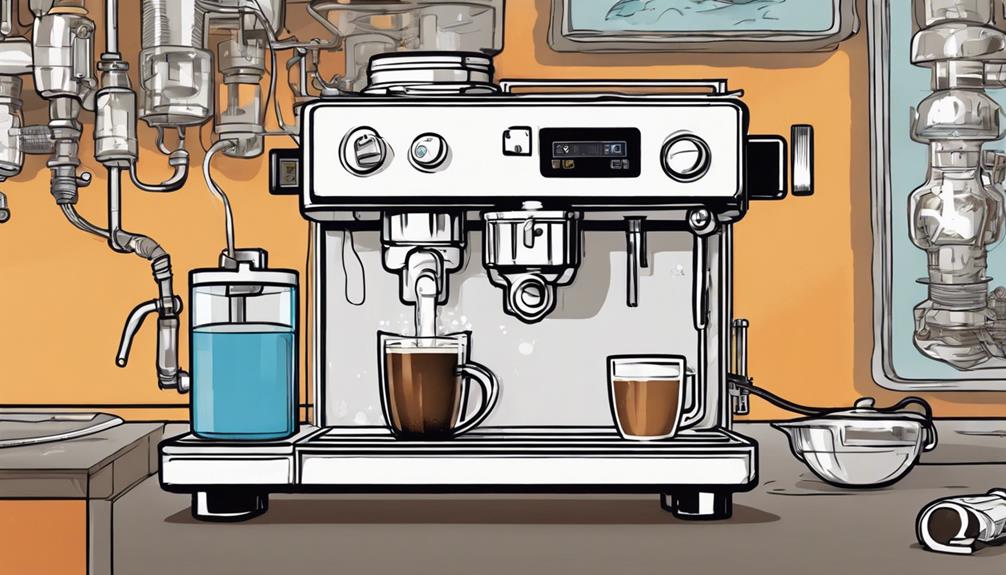
Having water of exceptional quality and no noticeable odors is important when aiming to brew outstanding espresso. To optimize the best results, it is vital to use pure water with the right mineral content for prime espresso extraction. Charcoal filtering is recommended, especially for municipal water sources, as it helps eliminate impurities that could impact the flavor and quality of the espresso.
Consider the following table to comprehend the ideal water parameters for brewing espresso:
| Water Parameter | Ideal Range for Espresso |
|---|---|
| Hardness Level | Around 5 grains |
| Total Mineral Content | 150 mg/L |
It's noteworthy to mention that using water that is too soft can result in a weak, metallic-tasting espresso shot, while water that is too hard may lead to scaling in the espresso machine, impacting the extraction process. By paying attention to water quality and maintaining the right balance of minerals, you can enhance the overall espresso experience.
Blend Crafting Expertise
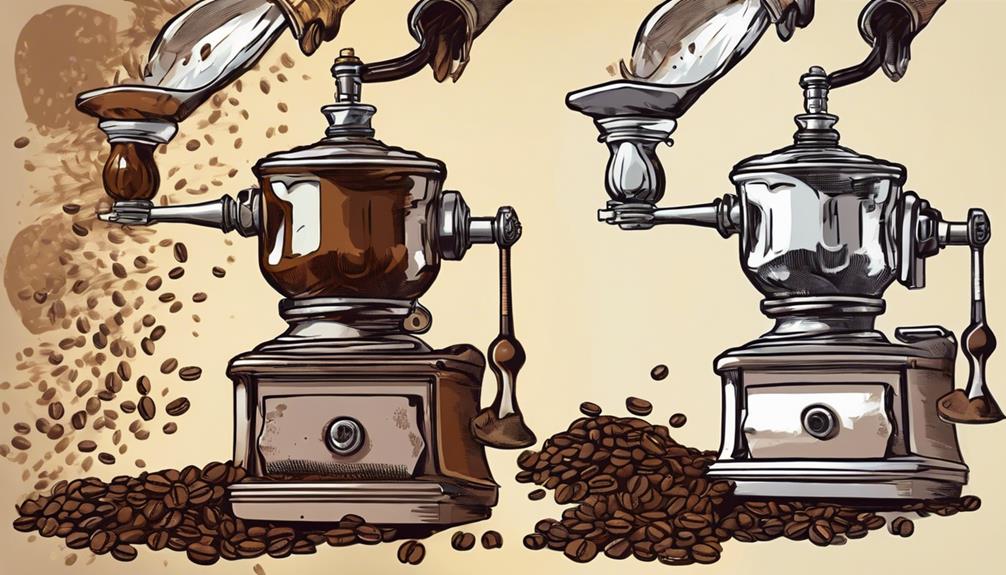
Crafting the perfect espresso blend requires honing your expertise in selecting and combining coffee beans. You must consider the origin, roast level, and flavor profile of each bean to create a balanced and complex blend. Experimenting with different ratios and varieties of beans can result in a unique and memorable espresso blend. For an added twist, consider incorporating a coffee and chicory blend to add depth and earthiness to your espresso. This can create a rich and savory flavor that sets your blend apart from the rest.
You need to understand how different origins, roast levels, and blending techniques influence the taste profile.
Precision in considering each bean's characteristics is key to creating a complex and satisfying espresso experience.
Blend Development Process
Developing blends for espresso requires honed expertise in the intricate art of coffee blending, cultivated through years of experience and experimentation with various origins. A blending expert understands the delicate balance needed to create a successful espresso blend, considering factors like richness, body, and acidity levels. In addition to traditional espresso blends, a blending expert may also have the knowledge and skill to create unique and unconventional blends, such as a coffee and chicory blend. Experimenting with different ratios and roast levels is essential to finding the perfect combination that results in a well-balanced, flavorful drink. With a deep understanding of the nuances of each individual component, a blending expert can create a coffee and chicory blend that is both bold and smooth, with a hint of bitterness from the chicory that complements the richness of the coffee.
Detailed cupping notes play a pivotal role in the refinement process, allowing the expert to fine-tune the blend with each iteration.
For instance, the renowned Has Bean Espresso blend exemplifies the skill of a blending expert, receiving critical acclaim for its harmonious flavor profile. Crafting a successful espresso blend involves learning from both mistakes and unexpected discoveries along the way.
Achieving the desired balance of flavors and aromas requires patience, dedication, and a deep understanding of how different coffee beans interact with each other. Through continuous experimentation and refinement, blending experts can create exquisite espresso blends that delight coffee enthusiasts worldwide.
Expertise in Blending
Expert blenders demonstrate their mastery by skillfully combining different coffee beans to create unique taste profiles for espresso blends. Crafting expertise in blending involves a deep understanding of how various beans interact to produce flavors that stand out. An expert blender may have honed their skills over years, curating a repertoire of over 200 blends from a multitude of origins. They meticulously analyze detailed cupping notes to continuously refine their blends, aiming for perfection in creating exceptional espresso blends.
| Key Characteristics | Description |
|---|---|
| Years of Experience | Expert blenders often have years of experience, allowing them to create a wide array of unique blends. |
| Customer Preferences | Understanding customer preferences is vital for an expert blender to tailor blends to specific tastes. |
| Blend Refinement | Continuous improvement of blends ensures that expert blenders consistently deliver exceptional espresso. |
| Balanced Flavor Profiles | Expert blenders avoid overly acidic or complex blends, aiming for a harmonious and rich espresso flavor. |
| Adaptability | Recognizing the ever-changing nature of blends is a key trait of an expert blender in the coffee industry. |
Taste Profile Precision
To achieve a precise taste profile for your espresso blend, focus on understanding the nuances of each coffee bean's flavor and how they interact harmoniously when combined. Blending expertise plays a pivotal role in creating a harmonious flavor balance that enhances the overall espresso experience.
Expert blenders experiment with different bean combinations to discover the perfect blend that highlights the taste nuances of each coffee bean. By selecting beans with complementary flavors, blending experts can craft a well-rounded espresso blend that delights the palate.
Crafting an exceptional espresso blend requires a deep understanding of flavor profiles and a keen sense of taste. By honing your blending skills and paying attention to the intricacies of each bean, you can create a harmonious flavor profile that stands out.
The art of blending coffee involves precision and attention to detail to guarantee that every sip delivers a delightful and well-balanced experience. Mastering taste profile precision is the key to revealing the full potential of your espresso blend.
Roasting Influence
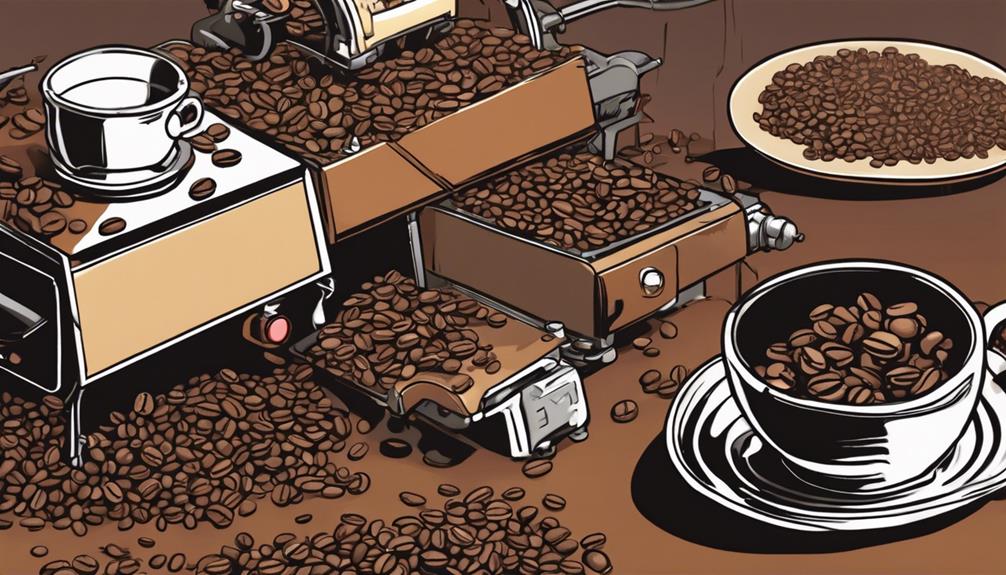
Enhancing the flavors and aromas of coffee beans, roasting plays a pivotal role in shaping the taste of your espresso blend. Different roast levels result in varied flavor profiles in espresso blends. Lighter roasts tend to preserve the bean's natural characteristics, offering a brighter and more acidic taste, while darker roasts bring out richer, bolder flavors with hints of caramel or chocolate notes.
The roasting process involves carefully monitoring temperature and time to achieve the desired balance of flavors for a well-rounded espresso.
Roasting influence extends beyond just flavor; it also impacts the extraction process. Proper roasting is essential for achieving a balanced extraction, where the water can efficiently dissolve the coffee compounds without over-extracting or under-extracting, leading to a harmonious and flavorful espresso.
Understanding the intricacies of roasting techniques is vital for developing the rich and complex taste that defines a high-quality espresso blend.
Recommended Recipe Highlights

Blending different coffee beans in your espresso recipe can elevate the overall flavor profile and complexity of your brew.
When creating your espresso blend recipe, consider the following recommended highlights:
- Ethiopian Yirgacheffe: Add this for citrus bursts that brighten the flavor profile.
- Brazilian Bourbon Fazenda Cachoeira: Incorporate this to introduce a touch of sweetness to your espresso blend.
- Colombian La Manuela: This coffee bean brings body and silkiness, enhancing the overall texture of your espresso.
- Ethiopian Longberry Harrar: A small amount of this bean can intensify the flavor notes in your blend.
Brewing Essentials

Achieving the ideal espresso requires precise grinding and water temperature control for best extraction. When brewing espresso, using a high-quality espresso machine is essential to guarantee consistent results.
The grind size plays a critical role in extraction time and flavor profile. A finer grind leads to a slower extraction, resulting in a more intense flavor, while a coarser grind extracts faster, producing a milder taste. Balancing these factors is key to achieving a well-rounded and balanced flavor profile in your espresso.
Maintaining the correct water temperature is equally important. Water that's too hot can lead to over-extraction, resulting in a bitter taste, whereas water that's too cool may under-extract, leading to a weak and sour shot.
Frequently Asked Questions
How to Get the Perfect Espresso Grind?
To get the perfect espresso grind, use a burr grinder for consistent fineness like powdered sugar. Adjust the grind size to control extraction time and flavor. Over-extraction means too-fine, under-extraction means too-coarse – taste test for perfection.
How to Make a Perfect Blend Coffee?
You start by selecting high-quality beans with diverse flavors. Experiment with ratios and roast levels to achieve flavor harmony. Taste and adjust until your blend dances on your palate. Balancing flavors creates a symphony in every sip.
How Do You Make the Perfect Espresso?
To make the perfect espresso, grind your beans finely and verify water temp is precise. Look for crema as a sign of a well-brewed shot. Master the balance of art and science in your brewing techniques for espresso excellence.
What Blend of Coffee Is Best for Espresso?
For the ideal espresso, go bold! A balanced blend of Arabica and Robusta beans from various regions, carefully roasted for best flavor. Experiment with ratios and roast levels to craft a harmonious, complex taste.
Conclusion
So, next time you're brewing up a delicious espresso, remember these key points for the perfect blend! First, make sure to use high-quality, freshly ground coffee beans for the best flavor. Additionally, pay attention to the water-to-coffee ratio and adjust it to suit your taste preferences. Finally, experiment with different brewing methods to find out how to blend coffee in a way that best brings out its unique flavor profile. Happy brewing!
Did you know that over 90% of espresso blends are made up of a mix of Arabica and Robusta beans?
Experiment with different ratios and roast levels to find your ideal flavor profile.
With the right ingredients and techniques, you'll be well on your way to enjoying a truly excellent cup of espresso every time.
Cheers to delicious coffee!
